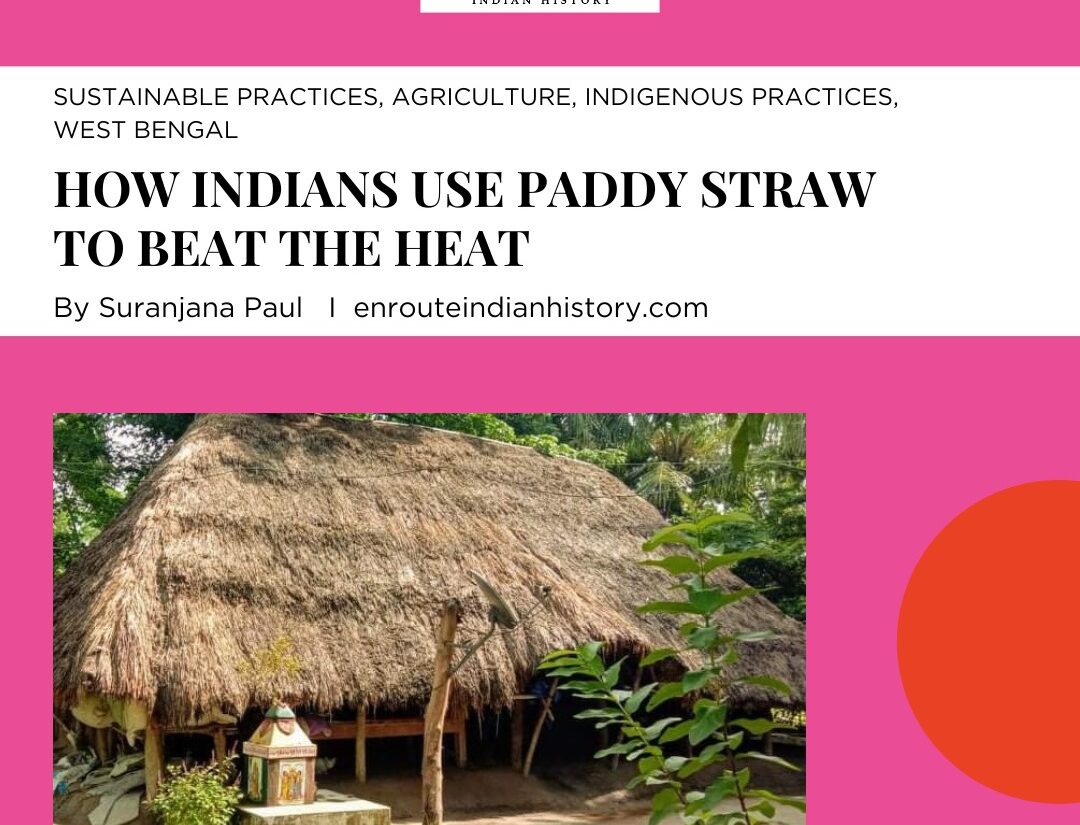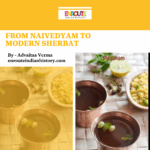How the Worship of Mother Goddess has Tantric Roots?
- EIH User
- February 7, 2024
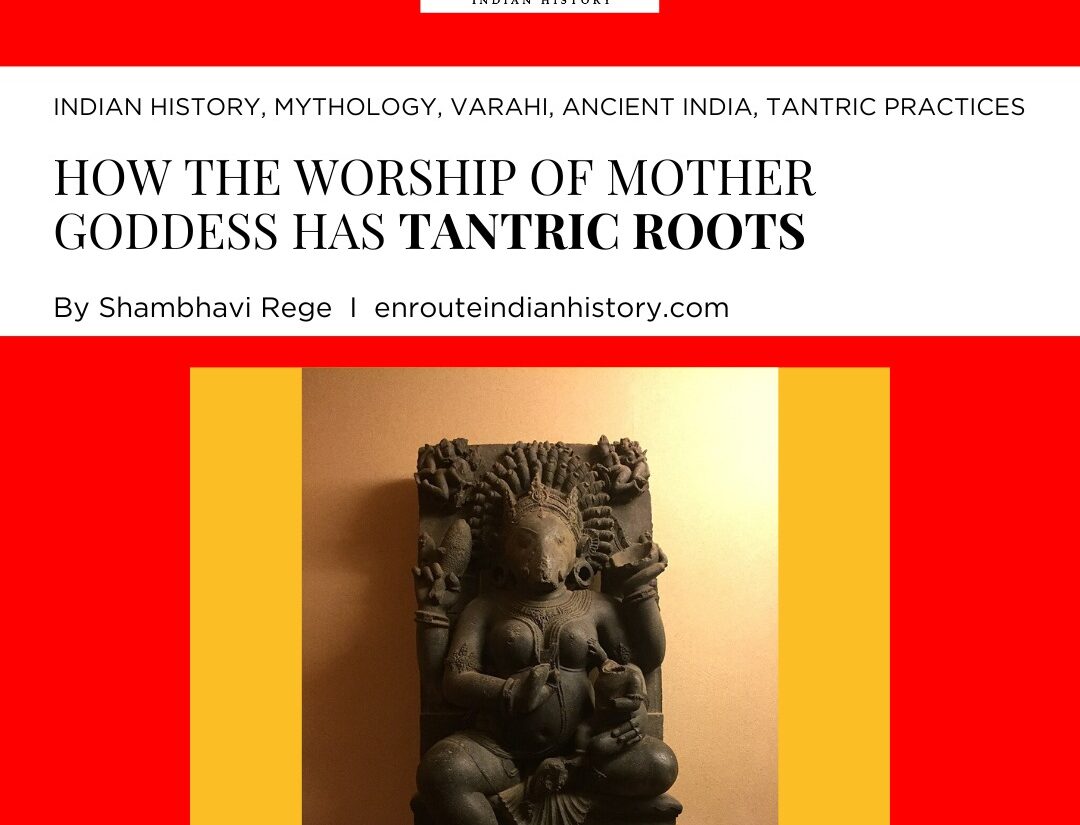
The concept of Saptamatrikas (seven mother goddesses) is of great importance in ancient Indian texts. These seven goddesses are said to be the energies of their male counterparts. These seven goddesses are as follows – Brahmani, Maheshvari, Kaumari, Vaishnavi, Varahi, Indrani and Chamunda. Out of these seven, Varahi is the female counterpart or energy of Varaha (incarnation of Vishnu). Varaha finds mention in Indian mythology as the boar-faced deity that killed a demon named Hiranyaksha. As his female energy, Varahi was popular in ancient India and the medieval period. The rise of tantric practices also made her worship popular. She has a fierce form and a powerful demeanour that eventually leads to her disappearance from present-day mainstream gods and goddesses. Her worship patterns are unique and it’s rare to find individual temples of Varahi.
The Saptamatrika Panel
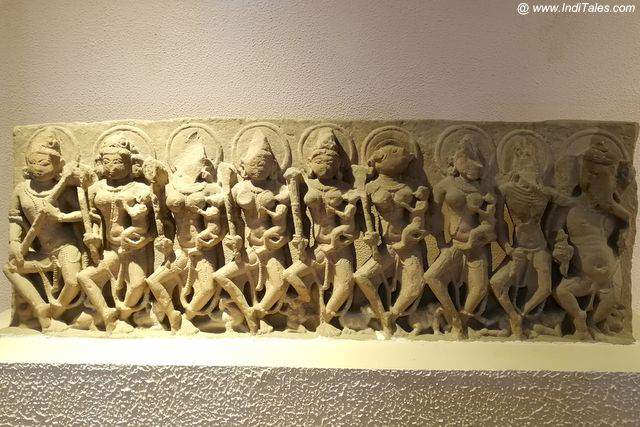
(Source – Anuradha Goyal, Saptamtrikas – legends, history, iconography and temples, Indi Tales
https://www.inditales.com/saptamatrikas-legends-history-iconography-temples/)
The seven divine mothers or the Saptamatrikas are surrounded by an enigmatic aura in Indian history. The study of Saptamatrikas has been undertaken by various scholars who researched the goddesses, their origins, their iconography and their prevalence in tantric practices. Each of the goddesses is the Sakti or energy of a god. They are depicted with the same attributes and vahanas as the gods. They are often placed together on panels in temples. They hold great meaning in the goddess-oriented sects of Hinduism and Tantrism. In Shaktism, they are believed to have aided Shakta Devi in her fight with the demon Andhaka. In earlier references, they are cited as fierce and inauspicious. In later mythology, they were seen in the role of protectors. Markandeya Purana has the earliest reference to Saptamatrikas. Their iconographic depictions can be found in ancient Indian texts like agamic texts and Devi Mahatmya. Out of the seven goddesses, the goddess Chamunda is often portrayed in a fierce form. She is commonly associated with the tantric practices. Although lesser known, Varahi too is depicted with a fierce form. She is said to have a dark complexion and ferocious expressions. This boar-faced deity is associated not only with Shaktism but also with Vaishnavism and tantrism. She is one of the manifestations of 64 yoginis and a mother goddess. Created to annihilate demons like Chanda, Sumbha, Nisumbha.
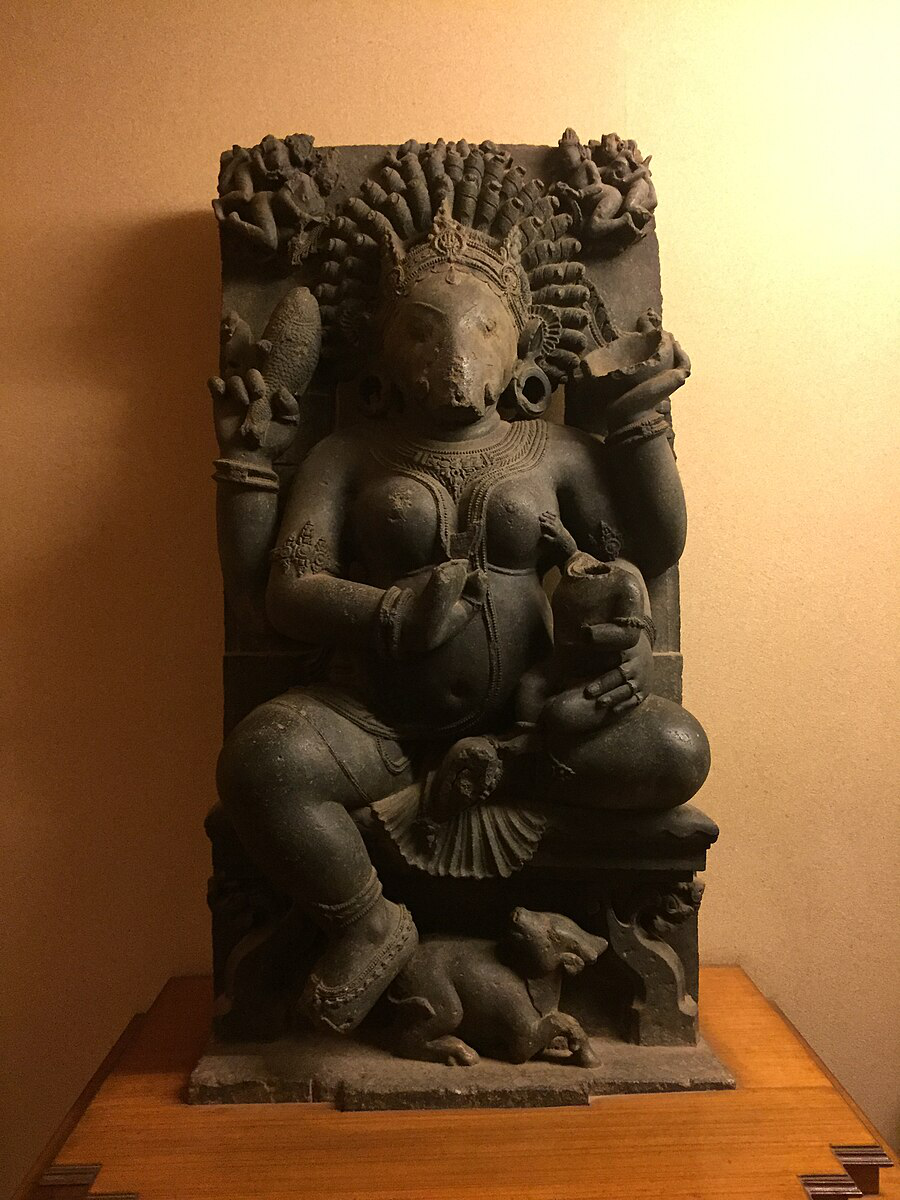
Sculpture of Varahi. She is depicted with 4 hands. A child is seated on her lap. The sculpture is presently on display in Odisha state museum
(Source – Sailesh Patnaik)
Saptamatrikas and Varahi
The Saptamatrikas appeared in sculptural depictions throughout India. They are often depicted in a group of 7, sometimes flanked by Ganesha and Veerbhadra. The iconography of Varahi bears resemblance to the depiction of Varaha. Varahi is depicted as a short-statured female and has a boar face. She has the colour of a storm cloud. On her head, she wears the Karandamukuta and wears ornaments made of corals. Her attributes are a Hala (plough) and Shakti. She is seen sitting under the Kalpa tree. Her vahana (mount) is a Buffalo. Sometimes she is depicted with a big belly. When she is depicted with 6 hands, her attributes are Danda, Khadga (sword), Khetaka and Pasa (noose). Her two hands are depicted in Abhay and Varada mudra (boon giving). Although the sculptural representation of Varahi is often depicted alongside the group of Saptamatrikas, individual iconographic representation is also noticed. Though it is rare, individual temples of Varahi can be found in Orissa, a prominent centre of Shaktism in ancient India.
Varahi cult with special reference to Orissa
In Orissa, the origin of the Shakta cult is traced back to the pre-Gupta age. The Kalika Purana has mentions of Odra (i.e. Orissa) as one of the Shakti peethas. Chamunda worship was prevalent. The shrines at Jajapur and Bhubaneshwar have Chamunda as their principal deity. The Kapalini temple also has the icon of Chamunda. A Saptamatrikas panel along with yogini representation is also present. Chamunda was not the only popular mother goddess in Orissa. Varahi was quite popular. The Varahi temples at Chaurasi and Vaitala are one of the rare examples of individual Varahi temples. The Varahi temple at Chaurasi is a Khakhra shrine. The Khakhra shrines are known for being the shrines of a Shakti or a female deity. This temple is situated near the Prachi Valley. This valley region held significance for tantric practices. The image of Varahi in this temple represents her tantric form. The Varahi tantra mentions five forms of Varahi i.e. Svapna Varahi, Canda Varahi, Mahi Varahi, Kruccha Varahi and Matsya Varahi. Here it represents the Matsya Varahi form which finds mention in the Varahi tantra. Here she is depicted with three eyes and two hands. She is seated in lalitasana and holds a Kapala (human skull) and a fish in her two hands. Her mount, buffalo, is also depicted. The big belly represents her holding the universe inside her womb. There are two images of Varahi found in this temple premises, both holding a fish in one of their hands. Another individual Varahi shrine is found at Narendrapur, near Gadi. It is a single shrine temple.
Varahi temple at Chaurasi, Orissa
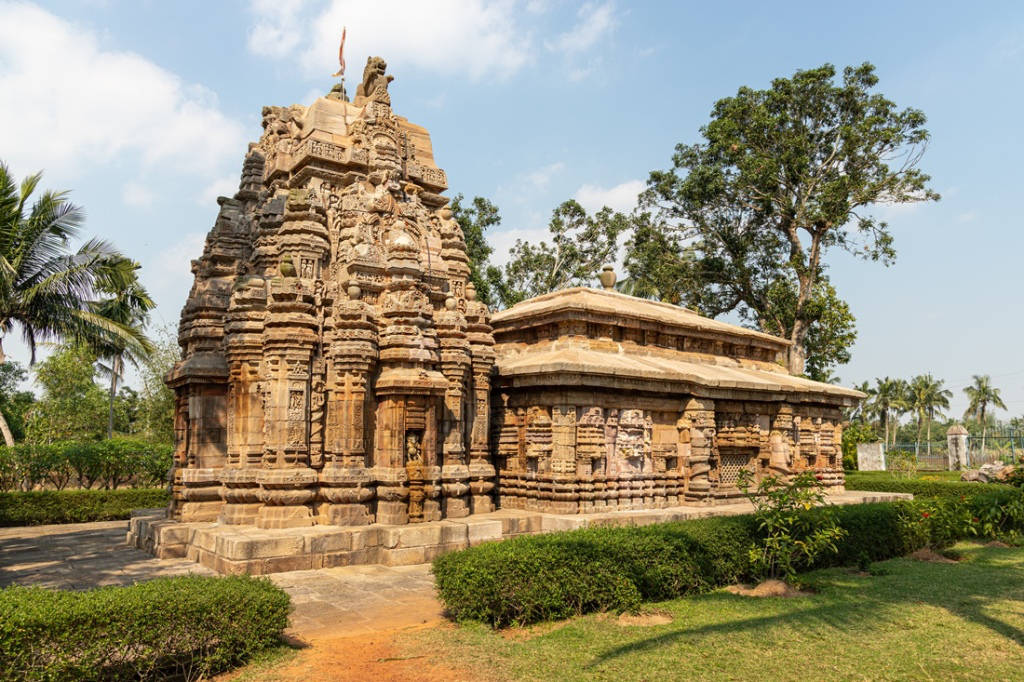
(Source – Kevin Standage photography, March 14, 2020
https://kevinstandagephotography.wordpress.com/2020/03/14/varahi-barahi-deula-temple-chaurasi-chaurashi/)
Tantric practices, Varahi, and decline
Out of the Saptamatrikas depictions and shrines of Chamunda are commonly found. Vaishnavi, Maheshwari and Chamunda became the mainstream goddesses. Though Varahi is also a dominant mother goddess, her worship in contemporary times is rare. Temples of Varahi found in India are also rare. According to tantric practices, her worship is not done during the daytime. Night, especially midnight, is considered an ideal time for the worship of Varahi. She should be revered only after sunset and before sunrise. In the temple at Chaurasi, she is offered fish every day. Although the worship of Varahi prevailed in Orissa during medieval times, in later times it was seen to be declined. In Indian history, Tantric practices were feared in some parts and the goddesses associated with it were seen with a mixture of reverence and fear. The mother goddess Varahi too has a fierce form and is related to the tantric practices. The worship of the goddess often includes tantra rituals and duties. The tantric rituals and practices are complex and often viewed as obscure. A common man cannot conduct it. It needs specialized knowledge of tantra.
Varahi not only has a fierce demeanor but also the worship and rituals come under the unconventional types. This might have made it less common for common people to take part in the worship. The worship of Varahi was prominent in regions in south India. But it’s not the same in every region. The goddess is also associated with a destructive ability. Her destructive power is a part of the necessary aspect of destruction and creation. But this nature is often feared. Almost all gods and goddesses associated with tantric practices are seen as powerful and destructive. Being a common thread in the three major sects i.e. Shaivism, Shaktism and Vaishnavism, along with tantrism, the Varahi deity attained a significant position that was both respected and feared. She is propitiated for destroying enemies.
In Indian mythology, Varaha was the incarnation of Vishnu. He had a boar face and was believed to have saved the goddess Earth (Bhumi). Amongst the Saptamatrikas, his female energy Varahi is also boar-faced and has the same attributes as the vahana (mount). The Saptamatrikas are placed in the panel in an order. Brahmani, Maheshvari and Kaumari signify the creation while Vaishnavi stands for balance. Varahi, Indrani and Chamunda signify destruction and fierce nature. This order symbolizes the creation and destruction cycle. Although Varahi stands for destruction she also is the energy behind creation and rejuvenation. Her association with the tantric practices throughout Indian history created a mythical aura around her. While this fierce form became the reason for widespread worship of Chamunda as the deity associated with war and protection, Varahi’s worship declined. Goddess Varahi is often seen in the Saptamatrika panels in temples and shrines. But her temples are rare to find. Not being the mainstream goddess, her popularity declined. Her worship patterns and rituals are also complex which led to a decline in her active worship. Although Varahi has not disappeared from the pages of Indian history, her negligible presence in the present day tells us about the loss of a mother goddess who is fierce, individually strong, powerful and has a dominant presence, characteristics that are shunned in females.
References
Behera, Dr.Antaryami. “Sakti cukt in western Odisha : A study of Samaleswarui of Sambhalpur .” International Journal of creative research thoughts (2022): 464- 468.
Choudhary, Dr.Janmejay. “Origin of Tatricism and Sixty-Four Yogini Cult in Orissa.” Orissa Review (2004): 7-9.
Ghadai, Balabhadra. “Shakti cult in Orissa .” Orissa review (2004): 19-21.
H.C.Das, Dr. “Cult of Varahi in Orissa.” Orissa review (2009): 80-84.
Mohapatra, Dr. Ratnakar. “Recent study on one khakhra type temple of Odisha in eastern India .” Journal of critical reviews (2020): 3801- 3813.
Mohapatra, Dr.Ratnakar. “Presiding deity image from the Sakta temples of Prachi balley in Odisha : A recent study .” The Journal of Indian Art History Congress (2018-1983-90).
Rath, Dr.Jayanti. “The Varahi temple of Caurasi.” Orissa Review (2007): 37-39.
- May 15, 2024
- 6 Min Read





